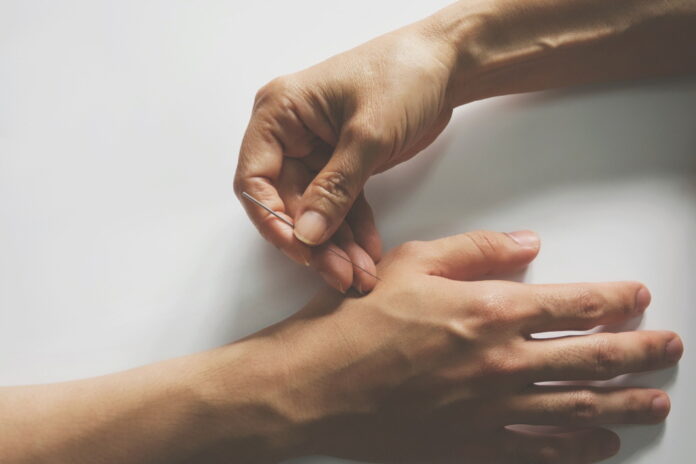
Acute Symptoms Can Be Easily Treated with Cleft Points Combinations
By Brandon SJ Oh, L.Ac.
Cleft points are located in each of the twelve meridians, yin heel vessel, yang heel vessel, yin link vessel, and yang link vessel. The cleft points are where the energy of each meridian is gathered and has strong power to affect its meridian.
The cleft point, which is belonged to the yin meridian, is used to cure hemostasis, and cleft points on the yang meridian are used to ease various acute pain.
We often face symptoms that require immediate care. For example, a thumb pain caused by being hit while hammering, a patient complained of swollen and painful testicles after being accidentally kicked out while playing soccer, and acute stomach pain with accessive amounts of vitamin C taken.
The cleft points are useful for the cases needed for instant medical treatment.
Cleft points
As we look up the word cleft in a dictionary, it means split, divided, or partially divided into two. Cleft points are located between bones or muscles, and Qi of its meridians is accumulated most. And the sensitivity and qi movement of a cleft point tends to be increased by exterior symptoms. As the cleft points are applied to your practice, it is strictly not recommended to use wet cupping on the cleft points because accumulated qi on the cleft point is lost through bleeding. As the blood moves, qi follows the movement of the blood.
There are rules to using cleft point for an acupuncture treatment. Cleft points on the yang meridians are used for acute muscular pain, and cleft points on the yin meridians have the role of hemostasis. Acute muscular pain is mostly caused by strained muscles or knots. The temporary circulatory disturbance is the most responsible for the muscular symptom. Therefore, the acupuncture points with strong qi should be used to resolve the disturbance of qi movement to reduce the knots.
The cleft points could be used as diagnostic tools by palpating the points.
Cleft points are selected by the location of pain and distribution of meridians, including yin and yang heel, and yin and yang link vessels. For example, if a patient complains of shoulder pain and the painful muscle is on or near the small intestine meridian, the cleft point should be found on the small intestine. Cleft points to the extraordinary vessels that can take care of both chronic symptoms with a new acute symptom. As a chronic low back pain patients starts to feel low back pain with acute leg numbness or paralysis. This is the case that requires a cleft point of an extraordinary vessel.
All cleft points are located lower than each elbow and knee except ST34, which is a cleft point of the stomach meridian. Because all the harmonizing acupuncture points are located on the elbows and knees, the ST34 is also considered as harmonizing points.
Rules for Applying Cleft Points
-Do not consider fullness or emptiness for acute symptoms such as excruciating pain or bleeding.
-Do not apply a rule to insert a needle on the yin meridian first on the upper body and the yang meridian on the lower body.
-Choose the most appropriate cleft point, insert a needle first, and then find four other meridians to guide qi moves in order by acupuncture stimulation.
-To guide qi movement through the four meridians, use Impulsive acupuncture points on each of the three meridians.
-Find the most suitable harmonizing acupuncture point among the four meridians to stabilize the qi movement.
-Harmonizing acupuncture point is selected as the closest harmonizing acupuncture point to the cleft point. For example, ST34, which is the cleft point of the stomach, and its location is close to the harmonizing point. So the ST34 is considered an Impulsive acupuncture point.
-All acute symptoms are needed to be treated with Taiji points.
-Eight meeting points where the qi of viscus, bowel, qi, blood, tendon, vessel, bone, and marrow gathers, respectively, should be used to increase the treatment effectiveness.
-After taking care of acute symptoms, the root cause should be diagnosed and treated.
<Indication of each cleft point>
|
Yin-Yang (陰陽) |
Meridian |
Cleft point |
Indications |
|
Three Yin Meridians on Arms (手三陰) |
Lung |
LU6(공최) |
coughing, hemoptysis, asthma, acrorrhaga |
|
Pericardum |
PC4(극문) |
palpitation, hiccup, chest pain, acute pleurisy |
|
|
Heart |
HT6(음극) |
palpitation, neurosis, angina, epilepsy, insomnia |
|
|
Three Yang Medirian on Arms (手三陽) |
Large Intestine |
LI7(온류) |
Sore throat, facial palsy, toothache, hemorrhoids |
|
Triple Burner |
TE7(회종) |
deafness, arm pain, heart pain |
|
|
Small Intestine |
SI6(양로) |
Upper and low back pain, earring |
|
|
Three Yang Meridians on legs (足三陽) |
Stomach |
ST34(양구) |
Stomach pain, gastrorrhagia, upper stomach pain, acute mastitis, acute diarrhea |
|
Gall Bladder |
GB36(외구) |
Colic seizure induced by cholelithiasis, hepatitis, epilepsy |
|
|
Urinary Bladder |
BL63(금문) |
Convulsion in childhood, stomach muscular spasm, paraplegia |
|
|
Three Yin Meridians on legs (足三陰) |
Spleen |
SP8(지기) |
Acute upper stomach pain, irregular menstruation, metrorrhagia, acute diarrhea |
|
Liver |
LV6(중도) |
hepatitis, testalgia, bloody discharge |
|
|
Kidney |
K5(수천) |
amenorrhea, cramps, descensus uteri |
|
|
Yin-Yang heel vessel (蹻脈) |
Yin heel vessel |
K8(교신) |
Leg pain, testalgia with swolling, amenorrhea |
|
Yang heel vessel |
BL59(부양) |
headache, low back pain, sciatica, paralysis |
|
|
Yin-Yang link vessel (維脈) |
Yin link vessel |
K9(축빈) |
cystitis, nephritis, detox, pain with swolling |
|
Yang link vessel |
GB35(양교) |
headache, acute hepatitis, chest pain, legs paralysis |
































